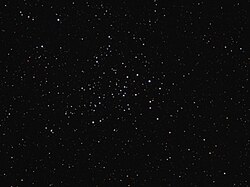NGC 1528
Appearance
| NGC 1528 | |
|---|---|
 NGC 1528 Open Cluster | |
| Observation data (J2000 epoch) | |
| Right ascension | 04h 15m 23s[1] |
| Declination | +51° 12′ 54″[1] |
| Distance | 2,530 ly (776 pc[2]) |
| Apparent magnitude (V) | 6.4 [1] |
| Apparent dimensions (V) | 23' |
| Physical characteristics | |
| Estimated age | 370 million years |
| Other designations | Cr 47 |
| Associations | |
| Constellation | Perseus |
NGC 1528 is an open cluster in the constellation Perseus. It was discovered by William Herschel in 1790. It is located in the north-eastern part of the constellation, just under 3 degrees north of μ Persei. Less than 1.5° to the southeast is the open cluster NGC 1545 (m = 6.2). The NGC 1528 is clearly visible with 10x50 binoculars. 165 stars are recognised as members of NGC 1528, the brightest of which has apparent magnitude 8.7.[3]
See also
References
- ^ a b c "NGC 1342". SIMBAD. Centre de données astronomiques de Strasbourg. Retrieved 2015-06-19.
- ^ WEBDA: NGC 1528
- ^ Stephen James O'Meara (2007). Deep-Sky Companions: Hidden Treasures. Cambridge University Press. pp. 131–132. ISBN 9781139463737.
External links
 Media related to NGC 1528 at Wikimedia Commons
Media related to NGC 1528 at Wikimedia Commons- NGC 1528 on WikiSky: DSS2, SDSS, GALEX, IRAS, Hydrogen α, X-Ray, Astrophoto, Sky Map, Articles and images
- SEDS
